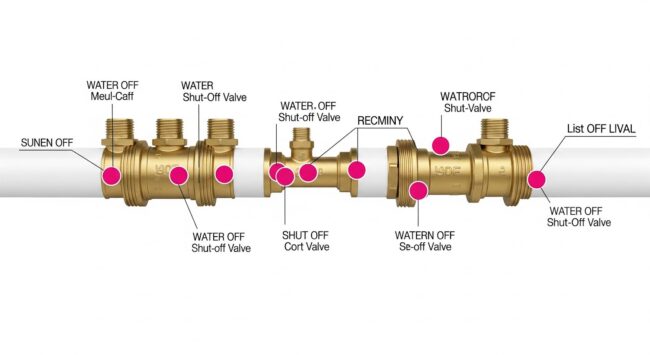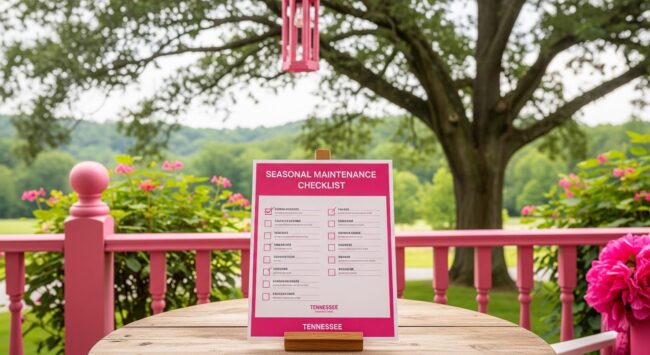You know that sinking feeling when you hear water dripping somewhere it shouldn’t be? Last Tuesday, I woke up to no hot water, and yes, even plumbers get plumbing surprises! But here’s the good news: most plumbing disasters are completely preventable with simple home plumbing maintenance.
After 15 years of fixing pipes across Tennessee with Pink Duck Plumbing, I’ve learned what works. Today, I’m sharing practical tips that’ll save you money and prevent those dreaded emergency calls.

Whether you’re tackling home improvements or just keeping things running smoothly, these tips will help you sleep better at night. Let’s dive in!
1. Find and Test Your Water Shut-Off Valves
Last month, the Johnsons had water spraying everywhere from a burst pipe. They were running around with buckets while their shut-off valve sat just 10 feet away; they simply didn’t know it existed.
Your main valve is usually near where the water line enters your home, basement, crawl space, garage, or outside near the foundation. In Tennessee, crawl spaces are common hiding spots (bring knee pads!).

Test it by turning clockwise. If it’s stiff, spray some WD-40 and work it gently. Also, check the shut-off valves under sinks and behind toilets, and test them yearly to prevent seizing. Pro tip: Take a photo of your main shut-off and share it with everyone in your household.
2. Become a Leak Detective
Mrs. Patterson’s water bill tripled before she noticed her toilet had been running silently for months. That sneaky leak cost her over $400. According to the EPA’s WaterSense program, household leaks waste approximately 10,000 gallons of water each year.
Here’s the water meter test: Turn off everything that uses water, then check your meter. If the dial’s moving, you’ve got a leak. Conduct monthly walk-arounds to check under sinks for stains, around toilets for dampness, and ceilings for watermarks.
My favorite trick? Put food coloring in your toilet tank before bed. If the bowl is colored by morning without flushing, replace that $10 flapper valve; it’ll save you hundreds.
3. Maintain Your Water Heater
Your water heater works harder than any other appliance in your home. With proper care, it’ll last 15 years instead of the typical 8-10.
Set the temperature to 120°F, hot enough for comfort, cool enough to prevent scalding. Every 10 degrees cooler saves about 5% on energy bills.
Annual flushing is crucial. Attach a garden hose to the bottom spigot, run it outside, and let the water flow until it is clear. This removes sediment that makes your heater work overtime. While there, test the pressure relief valve by lifting the lever; you should hear water gurgle. No gurgle means it needs replacing.
4. Keep Drains Flowing Freely
Most clogs are preventable with simple home plumbing maintenance habits. In the kitchen, never pour grease down the drain; it solidifies in pipes like cholesterol in arteries. Keep a can for grease and trash it when full.
In bathrooms, use $3 drain screens to catch hair. Monthly, pour boiling water down each drain, followed by a mixture of baking soda and vinegar. Let it fizz for 10 minutes, then flush with hot water. Skip harsh chemicals, they damage pipes and Tennessee’s waterways.
For stubborn clogs, invest in a $25 drain snake. It’s more effective than plunging and makes you feel like a real plumber.
5. Protect Pipes from Tennessee Weather
Tennessee’s weather can be unpredictable, with temperature swings from 70 degrees on Monday to freezing temperatures on Tuesday, which can be tough on plumbing. Wrap exposed pipes in crawl spaces, attics, and along exterior walls with foam insulation sleeves.
During cold snaps, let faucets drip overnight and open cabinet doors to circulate warm air. Never set your thermostat below 55°F when traveling. If pipes freeze, thaw slowly with a hair dryer; never use a torch.
6. Give Toilets Regular Checkups
Toilets use 30% of your home’s water. A running toilet wastes 200 gallons daily. Perform the food coloring test quarterly, ensure the water sits an inch below the overflow tube, and verify that your toilet doesn’t wobble (tighten bolts gently, as they can crack easily).
Want to save water? Drop a toilet tank bank in your tank to reduce water per flush by 20%.
7. Treat Your Garbage Disposal Right
Run cold water before, during, and after grinding; it keeps the grease solid for chopping. Monthly maintenance: grind ice cubes to sharpen blades, then citrus peels for freshness.
Never grind stringy vegetables, expandable foods (rice, pasta), coffee grounds, or bones. When in doubt, compost or trash it.
8. Upgrade to Water-Efficient Fixtures
Modern fixtures save money without sacrificing performance. Start with $5 faucet aerators, which cut flow by 30% while maintaining pressure. New showerheads use 40% less water but feel just as satisfying.
Consider dual-flush toilets or retrofit kits. Outside, fix leaky hose bibs and upgrade to water-smart sprinkler heads. Small changes add up to big savings.
9. Create a Seasonal Maintenance Schedule

Spring: Check outdoor faucets for freeze damage, clean gutters
Summer: Inspect washing machine hoses, monitor water usage
Fall: Winterize outdoor faucets, service water heater
Winter: Keep cabinets open during freezes, and know your shut-off location
10. Know When to Call Professionals
Call immediately for: no water pressure house-wide, sewage backups, major leaks, or gas water heater issues. Schedule pros for persistent drain problems, running toilets despite repairs, or unexplained high water bills.
Build a relationship with a plumber before emergencies. Many offer maintenance agreements that include annual inspections, which can be considered a form of plumbing insurance.
Your Home Plumbing Maintenance Action Plan
Start small this weekend: find your shut-off valve and check for leaks under sinks. Create a simple checklist and post it inside a cabinet. Include monthly tasks (leak checks, disposal cleaning) and annual jobs (water heater flush).
Document your plumbing with photos, valve locations, fixture ages, and maintenance dates. Keep them in your phone for quick reference.
Remember, consistent small efforts prevent big problems. Whether you’re in an old farmhouse or a new subdivision, these practices work. Every step protects your family home and saves money.
The Bottom Line
After 15 years of fixing plumbing problems, I’ve come to realize that prevention beats repairs every time. A $3 drain screen beats a $300 drain cleaning. Taking care of your plumbing requires some knowledge, consistency, and occasionally getting your hands a bit dirty.
Start today by checking that shut-off valve, tossing ice in your disposal, and scheduling water heater maintenance. Your future self will thank you when you’re not dealing with emergencies during dinner parties.
While these home plumbing maintenance tips address most situations, don’t hesitate to call a professional when needed. There’s no shame in getting help. We want to keep your home safe and dry.
Here’s to lower water bills, dry basements, and pipes that flow freely. May your water stay hot and your plumber’s number remain unused (but keep it handy, just in case).
Stay dry, Tennessee!
